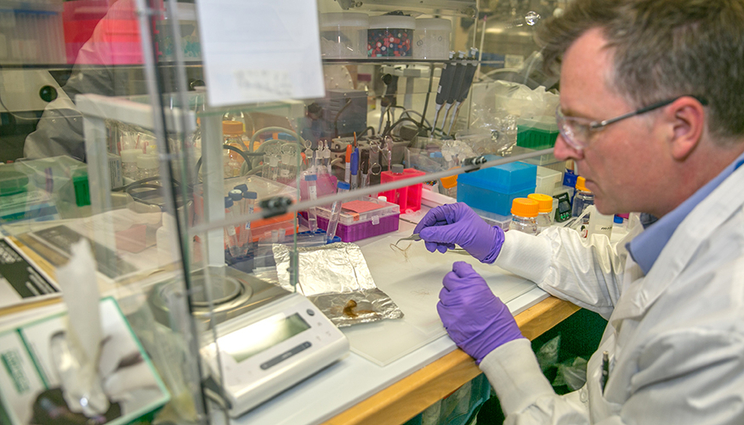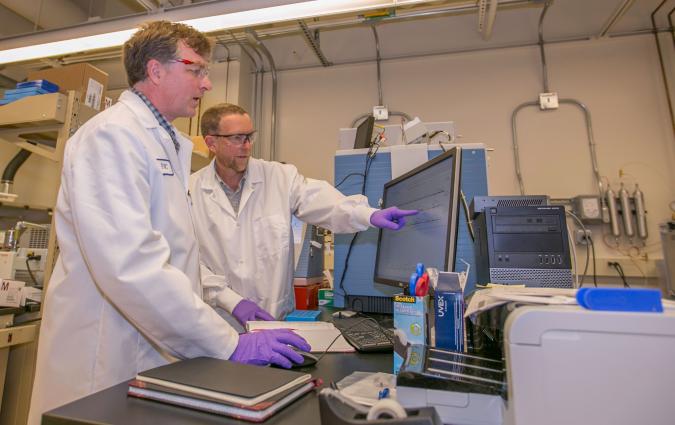Splitting hairs to advance forensic science
 (Download Image)
Glendon Parker, a biochemist with Lawrence Livermore's Forensic Science Center, is developing an identification method that relies on information encoded in the proteins of hair. Photos by Julie Russell/LLNL
(Download Image)
Glendon Parker, a biochemist with Lawrence Livermore's Forensic Science Center, is developing an identification method that relies on information encoded in the proteins of hair. Photos by Julie Russell/LLNL
With initial help from his work at a Utah university, an Australian-born biochemist is partnering with Lawrence Livermore National Laboratory (LLNL) to discover a second science-based forensic tool for identifying people in addition to DNA profiling.
Now an LLNL contract employee, Glendon Parker is working with the Lab's Forensic Science Center employees to develop a biological identification method that relies on the information encoded in proteins of human hair.
Parker credits part of the forensic science breakthrough to the support he received during his five years from 2008 to 2013 as an assistant professor at Orem-based Utah Valley University, and particularly to the scientific resources and multidisciplinary approach used at LLNL to address technical challenges.
"This project has so many moving parts and each part is in a different discipline.
"We have one researcher (Deon Anex) who is skilled in liquid chromatography-mass spectrometry and analytical chemistry; we have a bioinformaticist (Marisa Torres) who manages and develops our data flow; and we have a postdoc (Katelyn Mason) who is excellent at chemical processing, sample preparation and method development," Parker said.
"In addition, our multidisciplinary team has two biologists — Bonnee Rubinfeld and Cheryl Strout — who bring extensive experience in processing samples and establishing standard operating procedures to bear for our research."
Parker, 48, who immigrated to the United States in 1995, had invested a lot of time and work into developing the new forensic method —based on the number and pattern of protein markers in hair — but hadn’t gotten as far as he wanted.
Then the needs of the U.S. Department of Defense (DoD), the Laboratory’s Forensic Science Center and Parker all serendipitously converged.
One day in late 2012, a DoD agency sponsor who wanted to use hair as a way to identify people, visited LLNL and suggested that Lab Forensic Science Director Brad Hart should talk to the head of a federal agency’s DNA lab.
"When I called the federal agency, I was told Glendon Parker of Utah Valley University was working on a way to identify people using protein markers for human hair," Hart said
"I called Glendon and told him, ‘We’ve got this requirement for forensic identification and I understand you have a science-based approach that might help us.’ I had him come out to the Laboratory and give a talk and things went from there. Glendon moved out to California and we started the collaboration," Hart explained.
By March 2013, Parker was working as a contract employee at LLNL.
Parker believes three factors in his career path and personal life proved pivotal in the development of the new science-based forensic tool.
"First, I had spent two years looking at mass spectrometry data for diabetes research and I got a good feel for what we could learn from mass spectrometry. Second, my wife is a geneticist, and I was able to get a feel for basic genetics.
"And finally, when I left working as a scientific researcher, I became an assistant professor at Utah Valley University and started writing grants to secure equipment for our students. I wanted to develop new science projects for which we could use our instrumentation. That’s where my idea came from for protein-based identification."
Another boost for his work came from Utah Valley University.
"I wouldn’t be here without the support I received from the university, both from the College of Science and Health and from the university’s tech transfer office. The college allowed me to structure my teaching responsibilities so that I could start at LLNL, and provided initial funding for the project. These developments were important to my work."
The Lab’s development of a science-based, protein-based identification method for hair and other tissues comes at a time when the subjective method of hair comparison has run into trouble.
In 2013, a consortium was formed to review about 3,000 criminal cases in which the FBI used microscopic hair analysis to help convict defendants.
Among the organizations participating in the study were members of the Innocence Project, the National Association for Criminal Defense Lawyers, the FBI and the Department of Justice.
Through April 2015, the consortium reviewed about 270 transcripts involving microscopic hair analysis and determined that about 95 percent of the transcripts had at least one error in testimony.
"One of the reasons we believe our protein marker identification method for hair and other tissues is so important is because hair comparison is intrinsically subjective and can lend itself to over-interpretation in criminal cases," Parker said.
Hart noted that LLNL researchers are trying to provide the forensic science community with another science-based tool for human identification.
"We believe we’ve made a very good start and we think we’re going to do better in identifying protein markers," Parker said. "The pieces of the puzzle seem to be coming together."
Contact
 Stephen Wampler
Stephen Wampler
[email protected]
(925) 423-3107
Related Links
“A new role for hair in human identification”Utah Valley University
Tags
Global SecurityPhysical and Life Sciences
Featured Articles








